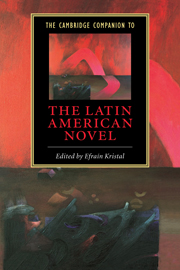1 - The nineteenth-century Latin American novel
from Part I - History
Published online by Cambridge University Press: 28 May 2006
Summary
As the nineteenth century began, Latin American writers had not yet produced a work that fully qualified as a novel, though many had written lengthy narratives with certain literary features. One reason for the delay was Spain’s ban on novels in its American colonies, though this ruling had proven difficult to enforce. In 1539, Mexico City came to house the first press in the New World, and Lima acquired a press in 1584, but these outlets were highly regulated. Authorized printing was controlled by the colonial government and was limited to official business and works with religious content. Privately owned presses operated outside these restrictions; unauthorized printing became increasingly widespread in the later years of the Colonial period.
Another obstacle to the development of the novel, even after the independence movements of the early nineteenth century, was the low prestige of the genre in comparison with such forms as heroic poetry. The reading of novels was associated in many people’s minds with idleness and escapism. The first Spanish American text that most critics consider a novel is the 1816 El Periquillo Sarniento (The Itching Parrot) by José Joaquín Fernández de Lizardi (Mexico, 1776-1827). For some time thereafter, novels appeared at a slow rate. Around mid-century, the genre assumed a more prominent place in Latin American literature and more examples of it came into being. During the final two decades of the nineteenth century, a great number of novels, many of lasting significance, held the attention of Spanish American readers.
El Periquillo Sarniento was an outgrowth of Lizardi’s newspaper El Pensador Mexicano (“The Mexican thinker”; the newspaper’s title came to be applied to its publisher as well). In February 1816, Lizardi began serializing El Periquillo Sarniento at the rate of two chapters a week. With this work, he sought to show that novels could serve a worthy purpose, providing readers with moral uplift and sound advice, particularly about molding young people into good citizens.
- Type
- Chapter
- Information
- The Cambridge Companion to the Latin American Novel , pp. 23 - 43Publisher: Cambridge University PressPrint publication year: 2005
- 1
- Cited by



